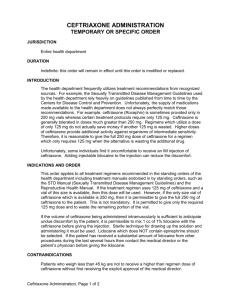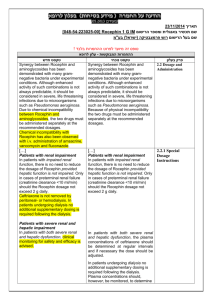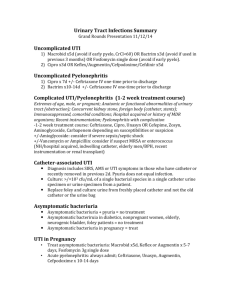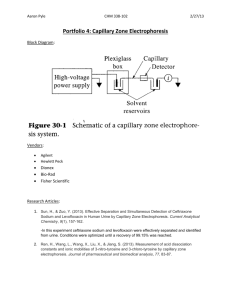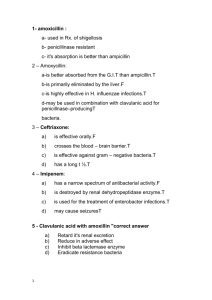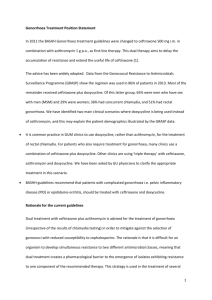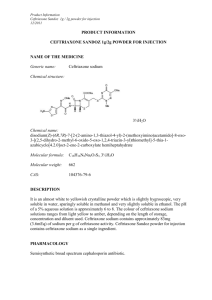Core Safety Profile (SmPC Sections 4.2
advertisement
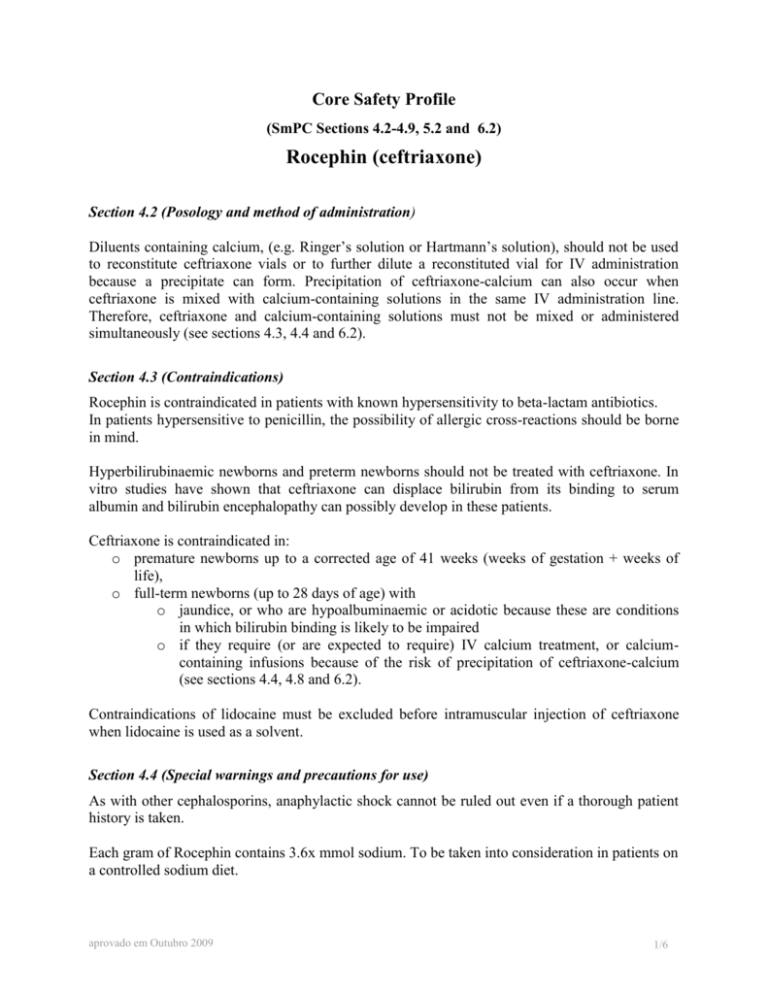
Core Safety Profile (SmPC Sections 4.2-4.9, 5.2 and 6.2) Rocephin (ceftriaxone) Section 4.2 (Posology and method of administration) Diluents containing calcium, (e.g. Ringer’s solution or Hartmann’s solution), should not be used to reconstitute ceftriaxone vials or to further dilute a reconstituted vial for IV administration because a precipitate can form. Precipitation of ceftriaxone-calcium can also occur when ceftriaxone is mixed with calcium-containing solutions in the same IV administration line. Therefore, ceftriaxone and calcium-containing solutions must not be mixed or administered simultaneously (see sections 4.3, 4.4 and 6.2). Section 4.3 (Contraindications) Rocephin is contraindicated in patients with known hypersensitivity to beta-lactam antibiotics. In patients hypersensitive to penicillin, the possibility of allergic cross-reactions should be borne in mind. Hyperbilirubinaemic newborns and preterm newborns should not be treated with ceftriaxone. In vitro studies have shown that ceftriaxone can displace bilirubin from its binding to serum albumin and bilirubin encephalopathy can possibly develop in these patients. Ceftriaxone is contraindicated in: o premature newborns up to a corrected age of 41 weeks (weeks of gestation + weeks of life), o full-term newborns (up to 28 days of age) with o jaundice, or who are hypoalbuminaemic or acidotic because these are conditions in which bilirubin binding is likely to be impaired o if they require (or are expected to require) IV calcium treatment, or calciumcontaining infusions because of the risk of precipitation of ceftriaxone-calcium (see sections 4.4, 4.8 and 6.2). Contraindications of lidocaine must be excluded before intramuscular injection of ceftriaxone when lidocaine is used as a solvent. Section 4.4 (Special warnings and precautions for use) As with other cephalosporins, anaphylactic shock cannot be ruled out even if a thorough patient history is taken. Each gram of Rocephin contains 3.6x mmol sodium. To be taken into consideration in patients on a controlled sodium diet. aprovado em Outubro 2009 1/6 Clostridium difficile associated diarrhea (CDAD) has been reported with use of nearly all antibacterial agents, including Rocephin, and may range in severity from mild diarrhea to fatal colitis. Treatment with antibacterial agents alters the normal flora of the colon leading to overgrowth of C. difficile. C. difficile produces toxins A and B which contribute to the development of CDAD. Hypertoxin producing strains of C. difficile cause increased morbidity and mortality, as these infections can be refractory to antimicrobial therapy and may require colectomy. CDAD must be considered in all patients who present with diarrhea following antibiotic use. Careful medical history is necessary since CDAD has been reported to occur over two months after the administration of antibacterial agents. If CDAD is suspected or confirmed, ongoing antibiotic use not directed against C. difficile may need to be discontinued. Appropriate fluid and electrolyte management, protein supplementation, antibiotic treatment of C. difficile, and surgical evaluation should be instituted as clinically indicated. Superinfections with non-susceptible micro-organisms may occur as with other antibacterial agents. Shadows, which have been mistaken for gallstones, have been detected on sonograms of the gallbladder, usually following doses higher than the standard recommended dose. These shadows are, however, precipitates of calcium ceftriaxone which disappear on completion or discontinuation of Rocephin therapy. Rarely have these findings been associated with symptoms. In symptomatic cases, conservative nonsurgical management is recommended. Discontinuation of Rocephin treatment in symptomatic cases should be at the discretion of the physician. Cases of fatal reactions with calcium-ceftriaxone precipitates in lungs and kidneys in premature and full-term newborns aged less than 1 month have been described. At least one of them had received ceftriaxone and calcium at different times and through different intravenous lines. In the available scientific data, there are no reports of confirmed intravascular precipitations in patients, other than newborns, treated with ceftriaxone and calcium-containing solutions or any other calcium-containing products. In vitro studies demonstrated that newborns have an increased risk of precipitation of ceftriaxone-calcium compared to other age groups. In patients of any age ceftriaxone must not be mixed or administered simultaneously with any calcium-containing IV solutions, even via different infusion lines or at different infusion sites. However, in patients older than 28 days of age ceftriaxone and calcium-containing solutions may be administered sequentially one after another if infusion lines at different sites are used, or if the infusion lines are replaced or thoroughly flushed between infusions with physiological saltsolution to avoid precipitation. In patients requiring continuous infusion with calcium-containing TPN solutions, healthcare professionals may wish to consider the use of alternative antibacterial treatments which do not carry a similar risk of precipitation. If use of ceftriaxone is considered necessary in patients requiring continuous nutrition, TPN solutions and ceftriaxone can be administered simultaneously, albeit via different infusion lines at different sites. Alternatively, infusion of TPN solution could be stopped for the period of ceftriaxone infusion, considering the advice to flush infusion lines between solutions. (see sections 4.3, 4.8, 5.2 and 6.2). aprovado em Outubro 2009 2/6 Cases of pancreatitis, possibly of biliary obstruction aetiology, have been rarely reported in patients treated with Rocephin. Most patients presented with risk factors for biliary stasis and biliary sludge, e.g. preceding major therapy, severe illness and total parenteral nutrition. A trigger or cofactor role of Rocephin- related biliary precipitation can not be ruled out. In severe renal and hepatic insufficiency, dosage should be reduced according to given recommendations. Safety and effectiveness of Rocephin in neonates, infants and children have been established for the dosages described under Dosage and administration. Studies have shown that ceftriaxone, like some other cephalosporins, can displace bilirubin from serum albumin. Rocephin should not be used in neonates (especially prematures) at risk of developing bilirubin encephalopathy. During prolonged treatment complete blood count should be performed at regular intervals. In case lidocaine is used as a solvent Ceftriaxone solutions should only be used for intramuscular injection. Section 4.5 (Interaction with other medicinal products and other forms of interaction) No impairment of renal function has so far been observed after concurrent administration of large doses of Rocephin and potent diuretics (e.g. furosemide). There is no evidence that Rocephin increases renal toxicity of aminoglycosides. No effect similar to that of disulfiram has been demonstrated after ingestion of alcohol subsequent to the administration of Rocephin. Ceftriaxone does not contain an N-methylthiotetrazole moiety associated with possible ethanol intolerance and bleeding problems of certain other cephalosporins. The elimination of Rocephin is not altered by probenecid. In an in-vitro study antagonistic effects have been observed with the combination of chloramphenicol and ceftriaxone. Do not use diluents containing calcium, such as Ringer’s solution or Hartmann’s solution, to reconstitute Rocephin vials or to further dilute a reconstituted vial for IV administration because a precipitate can form. Precipitation of ceftriaxone-calcium can also occur when Rocephin is mixed with calcium-containing solutions in the same IV administration line. Rocephin must not be administered simultaneously with calcium-containing IV solutions, including continuous calcium-containing infusions such as parenteral nutrition via a Y-site. However, in patients other than neonates, Rocephin and calcium-containing solutions may be administered sequentially, of one another, if the infusion lines are thoroughly flushed between infusions with a compatible fluid. In vitro studies using adult and neonatal plasma from umbilical cord blood demonstrated that neonates have an increased risk of precipitation of ceftriaxone-calicum. Based on literature reports ceftriaxone is incompatible with amsacrine, vancomycin, fluconazole and aminoglycosides. In patients treated with Rocephin, the Coombs' test may in rare cases be false-positive. Rocephin, like other antibiotics, may result in false-positive tests for galactosaemia. Likewise, non-enzymatic methods for glucose determination in urine may yield false-positive results. For this reason, glucose level determination in urine during therapy with Rocephin should be carried out enzymatically. aprovado em Outubro 2009 3/6 Ceftriaxone may adversely affect the efficacy of oral hormonal contraceptives. Consequently, it is advisable to use supplementary (non-hormonal) contraceptive measures during treatment and in the month following treatment. Section 4.6 (Pregnancy and lactation) Ceftriaxone crosses the placental barrier. Safety in human pregnancy has not been established. Reproductive studies in animals have shown no evidence of embryotoxicity, fetotoxicity, teratogenicity or adverse effects on male or female fertility, birth or perinatal and postnatal development. In primates, no embryotoxicity or teratogenicity has been observed. Low concentrations of ceftriaxone are excreted in human milk. Caution should be exercised when Rocephin is administered to a nursing woman. Section 4.7 (Effects on ability to drive and use machines) Since Rocephin sometimes induces dizziness the ability to drive and use machines can be impaired. Section 4.8 (Undesirable effects) The undesirable effects usually are mild and short-term in. Systemic side effects Gastrointestinal complaints (about 2% of the cases): loose stools or diarrhea, nausea, vomiting, stomatitis and glossitis. Hematological changes (about 2%): eosinophilia, leukopenia, granulocytopenia, hemolytic anemia, thrombocytopenia. Unknown frequency: of agranulocytosis (< 500/mm3) have been reported, most of them after 10 days of treatment and following total doses of 20 g or more. Skin reactions (about 1%): exanthema, allergic dermatitis, pruritus, urticaria, edema. Unknown frequency: of severe cutaneous adverse reactions (erythema multiforme, Stevens Johnson syndrome or Lyell’s Syndrome/toxic epidermal necrolysis) have been reported. Other, rare side effects: headache, vertigo and dizziness, symptomatic precipitation of ceftriaxone calcium salt in the gallbladder, increase in liver enzymes, glucosuria , hematuria , oliguria, increase in serum creatinine, genital mycosis, fever, shivering and anaphylactic or anaphylactoid reactions e.g., bronchospasms. Ceftriaxone must not be mixed or administered simultaneously with calcium-containing solutions or products, even via different infusion lines. Rarely, severe, and in some cases fatal, adverse reactions have been reported in preterm and fullterm newborns (aged <28 days) who had been treated with intravenous ceftriaxone and calcium. Precipitations of ceftriaxone-calcium salt have been observed in lung and kidneys post-mortem. The high risk of precipitation in newborns is due to their low blood volume and the longer half life of ceftriaxone compared with adults (see sections 4.3, 4.4 and 5.2). aprovado em Outubro 2009 4/6 Superinfection caused by microorganisms non-susceptible to ceftriaxone (candida, fungi or other resistant microorganisms) may develop. Pseudomembraneous colitis is a rare undesirable effect caused by infection with Clostridium difficile during treatment with Rocephin. Therefore, the possibility of the disease should be considered in patients who present with diarrhoea following antibacterial agent use. Very rare cases of renal precipitation have been reported, mostly in children older than 3 years and who have been treated with either high daily doses (e.g. 80 mg/kg/day) or total doses exceeding 10 grams and presenting other risk factors (e.g. fluid restrictions, confinement to bed, etc.) The risk of precipitate formation is increased in immobilized or dehydrated patients. This event may be symptomatic or asymptomatic, may lead to renal insufficiency and anuria, and is reversible upon discontinuation of Rocephin. Precipitation of ceftriaxone calcium salt in the gallbladder has been observed, mostly in patients treated with doses higher than the recommended standard dose. In children, prospective studies have shown a variable incidence of precipitation with intravenous application, in some studies to above 30 %. The incidence seems to be lower with slow infusion (20-30 minutes). This effect is usually asymptomatic, but in rare cases, the precipitations have been accompanied by clinical symptoms such as pain, nausea and vomiting. Symptomatic treatment is recommended in these cases. Precipitation is usually reversible upon discontinuation of ceftriaxone. There have been isolated reports of pancreatitis. Coagulation disorders have been reported as very rare side effects. Local side effects In rare cases, phlebitic reactions occurred after i.v. administration. These may be minimized by slow (2-4 minutes) injection. Intramuscular injection without lidocaine solution is painful. Influence on diagnostic tests In patients treated with Rocephin the Coombs’ test rarely may become false-positive. Rocephin, like other antibiotics, may result in false-positive tests for galactosemia. Likewise, nonenzymatic methods for the glucose determination in urine may give false-positive results. For this reason, urine-glucose determination during therapy with Rocephin should be done enzymatically. Intramuscular injection without lidocaine solution is painful. Section 4.9 (Overdose) In the case of overdose nausea, vomiting, diarrhoea, can occure. Ceftriaxone concentration can not be reduced by hemodialysis or peritoneal dialysis. There is no specific antidote. Treatment is symptomatic. aprovado em Outubro 2009 5/6 Section 5.2 (Pharmacokinetic properties) Pharmacokinetics in special clinical situations In the first week of life, 80% of the dose is excreted in the urine; over the first month, this falls to levels similar to those in the adults. In infants aged less than 8 days the average elimination halflife is usually two to three times longer than that of young adults Section 6.2 (Incompatibilities) Solutions containing ceftriaxone should not be mixed with or added to other agents. In particular diluents containing calcium, (e.g. Ringer’s solution, Hartmann’s solution) should not be used to reconstitute ceftriaxone vials or to further dilute a reconstituted vial for IV administration because a precipitate can form. Ceftriaxone must not be mixed or administered simultaneously with calcium-containing solutions (see section 4.2, 4.3, 4.4 and 4.8). aprovado em Outubro 2009 6/6

